Demonstrating the benefit of agricultural biotechnology in developing countries by bridging the public and private sectors
Abstract
The agricultural transformation of Brazil through soybean intensification in the Cerrado biome is the closest model that Africa could follow, given the similarities in land mass, shared biophysical constraints (especially soil), ecological diversity and low population density11. However, a single integrated market and regulatory environment must be created, and African scientists must lead the scientific innovation in Africa. Increased attention to soil health also bodes well for more-strategic public and private investments that could enhance the productivity of Africa’s acid savannahs while also helping to reduce pressure on more-fragile woodland and forest regions. Lessons should also be learned from the underutilization of the Biosciences eastern and central Africa (BecA) and International Livestock Research Institute (ILRI) hub, which aimed to support African countries in developing and applying bioscience research with the goal of helping resource-poor farmers to improve productivity and increase income. Reliance on international donor support or help does not provide long-term sustainability.
We have identified five technically sound, administratively feasible and politically supportable opportunities for agbiotech delivery and adoption: (1) convince international and national funding agencies to sustain project gains after the funding period for long-term impact; (2) facilitate regional stakeholder cooperation through a return on investment, and harmonize the regulatory framework for agbiotech product development and growth; (3) develop interdisciplinary partnerships to align interests and incorporate training, development and resource management in collaborative grants; (4) use existing resources and products for validation, delivery and adoption; and (5) promote science advocacy within the community through communication by scientists and educators with students, community leaders and policymakers.

